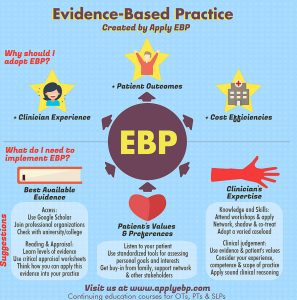Session (5)
Step 4: Applying the Evidence

Formulating the clinical question and acquiring and appraising research evidence is only part of the evidence-based practice process. Clinicians must integrate the evidence with patient values in order to determine the optimal care for an individual patient.
Applying the best evidence is arguably the Evidenced-Based Practice (EBP) step that requires the most skill. It is at this step that you synthesize the best scientific knowledge with your clinical expertise and the patient’s unique values and circumstances to reach a clinical decision:

Once you have determined that the study and its results are valid, you need to decide if it applies to your specific patient/population and situation.

Factors to consider include:
- Similarities between your patient/problem/population and those in the study.
- The needs and wishes of your patient or population.
- The clinical significance of the results.
- The availability interventions in your practice or setting.
- Remember that EBP balances three elements: 1) the latest, best evidence; 2) the patient or community’s values, needs, and preferences; and 3) your expertise.
- Diagnosis

Example application questions:
- Is the test affordable, accurate and available in my practice or hospital?
- How likely is it that my patient has the disease if the results are positive (i.e. positive predictive value or post-test probability of a positive test)?
- How likely is it that my patient does not have the disease if the results are negative (i.e. negative predictive value or post-test probability of a negative test)?
- Will the test results change my management decisions (i.e. treatment plan)?
- What is the cost (financial and otherwise) and relative value of alternate tests?
Example of patient-oriented application questions:
- Will my patient be better off because of this test?
- Will the diagnosis influence patient-important outcomes, e.g. quality of life, death, disability, cost, etc?
Therapy/Intervention
Example application questions:
- Is my patient similar enough to those in the study that the results would be valid?
- According to the study results, how much would my patient benefit from the treatment?
- Were the results clinically significant (i.e. change is tangible and valuable to patients) or just statistically significant?
Example of patient-oriented application questions:
What is the quality of life with this treatment as compared to others?
Does the intervention reflect my patient’s or community’s needs, values, and preferences?
Will my patient be able to adhere to the treatment requirements?
Harm
Example application questions:
- Can the study results be applied to my patient or population?
- How large is the risk identified in the study?
- How does the risk of the intervention compare with its potential benefits?
- Are there alternative interventions with a lower risk of harm?
- How do the potential harms align with the needs, values, and preferences of your specific patient or community?
Prognosis
Example application questions:
- Is my patient similar to the patients in the study group?
- How strong is the evidence behind the prognostic factor?
- Are the results useful for counseling your patient?
- What was the prognosis on related outcomes (e.g. disability and quality of life)?
Program/Quality Improvement
Example application questions:
- Is the setting or population of the article similar to your practice or community?
- Will this change improve safety concerns (e.g. protect patients from medical errors)?
- Is this change or program effective and efficient?
- Does this program align with the community’s needs, values, and preferences?
- Are there resources (money, staff, training, etc.) to support new programming?
Economic Evaluation
Example application questions:
- Are the treatment benefits worth the corresponding risks and costs?
- Will the costs be similar in your setting?
- Will implementing this new program or intervention result in decreased resources to existing services? What will be the consequences of that decrease?